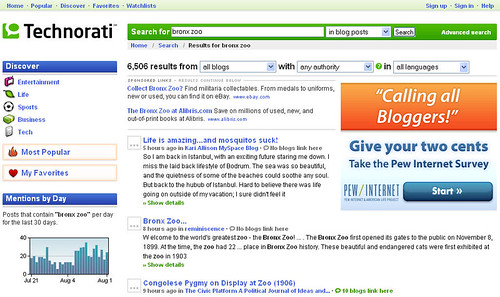Nationwide Random-Digit-Dial (RDD) telephone survey methodologies are great for producing for very general middle-America projections, and there’s a place for them. But they can be useless if you’re seeking to collect insights from smaller segments or niches, such as power bloggers. That’s why it’s great to see the Pew Internet & American Life Project advertising its latest blogger survey on places like Technorati (see below). This sort of advertising, while for market research purposes, is very much in line with the concept of "chatterbacking," which my colleague Pete Blackshaw recently coined:
Without fluff or hyperbole, it describes what’s happening in advertising today: advertisers, for better or worse, are piggybacking on the consumer "chatter."…The opportunity for advertisers in this environment is to wedge themselves in-front, between, behind, and all-around the chatter. And in some (less savory) cases, the objective is to co-opt and blend-in with the chatter.
But the marketing strategy behind this Pew survey also includes an element of word of mouth. (Through my mouth, you’re becoming aware of this survey, and there’s a good chance I’ll persuade you to go and take the survey.) In fact, it’s not all that different from a Jupiter corporate blogging and consumer-generated media study last year, where former Jup analyst Gary Stein promoted opt-in survey participation exclusively through word of mouth.
Many market research fogies cringe at this notion of social-network audience samples, but I think it’s an untapped, misunderstood and powerful framework for tapping into rich, naturally occurring audience segments, such as affinity, life stage and psychographics. Social-network samples have the power to exclude the diluting affects of over-simplistic RDD sampling techniques, often rooted in artificial demographic cuts, and, instead, penetrate very specific interests, niches, maps of influence and engagement.
These sorts of segments often better lend themselves to understanding human behavior, motivation and the rich nuances that differentiate groups and individuals. Of course, the challenge is to produce dimension around this type of segmentation: How big? How fast? What is the absolute population?
When Pew promotes results from this study, I hope its underscores many of the points I make above, and not deemphasize the results because they were not part of a nationwide telephone survey. Of course, qualification of methodology is critical. But it should promote this methodology of social-network samples.
(Disclosure: I’ve partnered with Pew and contributed to Pew Internet reports while working at two market research firms over the past several years, including the one where I work now. I have tremendous respect for the work that comes out of Pew, including that of the Internet & American Life Project, which is behind the blogger study I mention).

